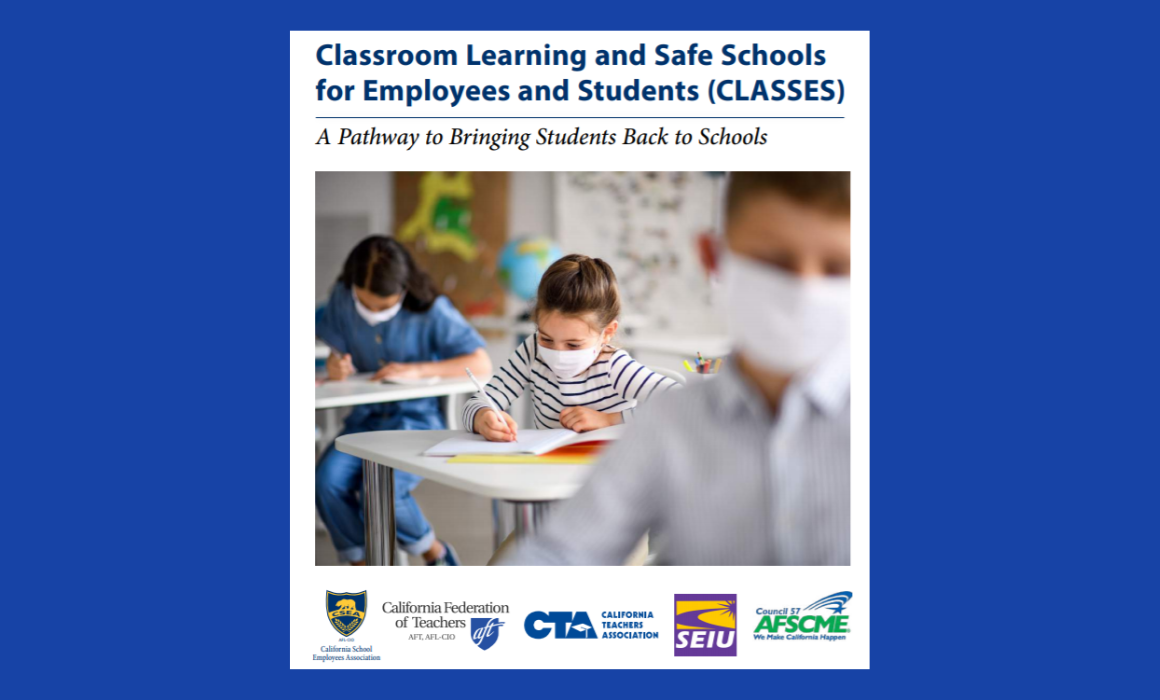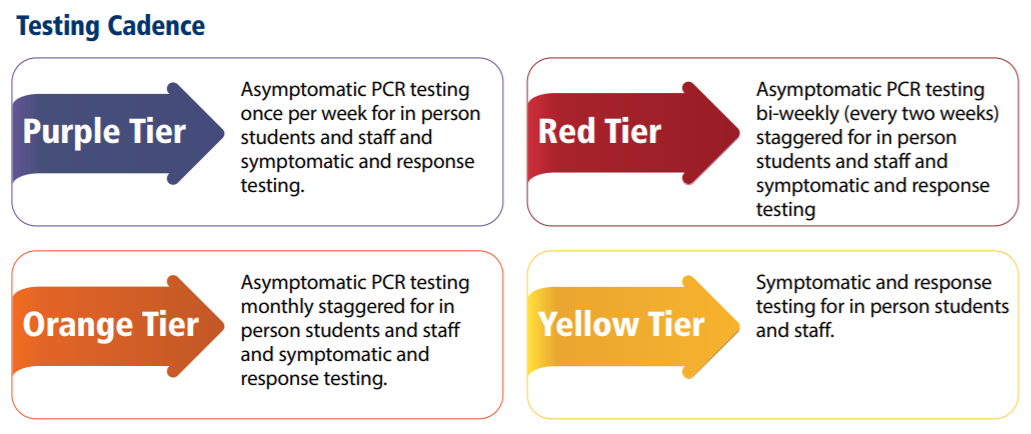
In the ongoing fight to protect public health, and in the absence of a feasible approach from state leaders, CTA and our partners in public education charted a path to in-person instruction in a new proposal released yesterday.
In a collaborative effort to return to classrooms as soon as possible, the coalition of education labor groups released the Classroom Learning and Safe Schools for Employees and Students (CLASSES) plan, which outlines the steps needed to physically return to schools safely. With COVID-19 still spreading uncontrolled across the state, the CLASSES plan takes a holistic approach to physically returning to schools that includes addressing the risk of community spread to ensure the safety of students, educators and their families.
“Our goal is to welcome all of our students back to classrooms in a way that keeps everyone safe,” CTA President E. Toby Boyd said. “The pandemic is still out of control, which is why we need a phased approach that includes multi-layered mitigation strategies and considers community conditions to ensure our collective health.”
The plan was developed by CTA, California School Employees Association, California Federation of Teachers, Service Employees International Union, and American Federation of State, County and Municipal Employees Council 57—representing nearly the entire public education workforce. As the coronavirus continues to mutate and threaten our communities with new variants that are more contagious and possibly more lethal, educators are committed to finding a path to return to in-person instruction that is safe for the entire school community: students, staff and families.
“California’s decisions today will determine community COVID-19 conditions, health equity and the safe operation of schools to provide in-person instruction and services to students and families,” the plan states. “Reopening schools for in-person instruction will involve substantial implementation, but together we can get students back to school campuses.”
The CLASSES plan is a summary of educators’ and school employees’ shared concerns and ideas around physical reopening to come to an agreement with elected leaders on how best to safely do so, and is not intended as a counter to Gov. Gavin Newsom’s Safe Schools for All plan.
“We know first-hand there is no equal to in-person learning and we want to be back in the classroom with our students as soon as safely possible,” Boyd said. “We look forward to working with the governor and legislators on finding a solution that safely reunites our members with their students.”
Prioritizing and Phasing Vaccinations is Key
To physically reopen schools, the plan calls for all employees reporting in person to be provided the opportunity to be vaccinated before students return to campus. The plan outlines prioritizing vaccinations for educators who are already working in person at school sites, especially those in school communities most impacted by the pandemic. The CLASSES pathway proposes a phased approach that starts with those who are currently working on campuses and adds others as they report to campus.
“The state must prioritize vaccinations for all educators already working on campuses and ensure all employees required to return are provided the opportunity to be vaccinated before students physically return,” Boyd said. “We look forward to working with the governor and legislators on finding a solution that safely reunites our members with their students.”
Multiple Mitigation Measures Needed to Protect Health
The CLASSES plan calls for a multi-layered approach to provide safe conditions for students and staff returning to in-person learning, specifically outlining the following strategies critical to reopen safely and protect the health of students, educators and their families:
- Prioritization for students in need – Phased approach: In-person instruction should be phased in starting with lowest grades and struggling students.
- Asymptomatic Testing – Testing is an essential layer of the mitigation strategies. Early identification and isolation of COVID-19 cases without symptoms through regular testing helps prevent outbreaks by checking if the mitigation strategies are working and improving understanding of infection risks in schools. In addition to symptomatic testing and response in all districts, the plan calls for asymptomatic PCR testing of all staff and students every week for schools in the Purple Tier, bi-weekly asymptomatic PCR testing in the Red Tier and monthly in the Orange Tier.
- Health/Safety Standards – In addition to the latest guidance from the California Department of Education and the COVID-19 Emergency Temporary Standards from Cal/OSHA, there are several areas that require further development to safely reopen schools for in person instruction, including cleaning standards, physical distancing and masking requirements and appropriate ventilation.

CLASSES also calls for COVID-19 Emergency Paid Sick Leave to prevent the virus from needlessly spreading in work environments. The Legislature must take immediate action to expand emergency paid sick days and paid family and medical leave protections to ensure workers can utilize this time before exhausting their personal paid leave.
These mitigation strategies will take significant resources to carry out and protect school communities. While Gov. Newsom has called for record Prop. 98 education funding next fiscal year, that money is intended for instructional purposes, not pandemic response measures. The CLASSES plan calls for the use of discretionary federal funds or general fund money to pay for these necessary health and safety improvements, as well as the use of an equity-based funding formula to mitigate the disproportionate impacts of COVID-19 in Black and Latino communities.
Community Health Concerns: Purple Tier is Not Safe for Return
No matter how safe we make our schools, the risk of students and staff bringing exposure into the school increases when effective multi-layered mitigation measures are not implemented in their communities. Therefore, the CLASSES plan calls for no new in-person instruction for schools in the state’s Purple Tier for COVID-19 risk. For the Red and Orange tiers, school districts should be permitted to open with the mitigation measures noted above, but not required to do so. In the Yellow Tier, the plan calls for districts to be required to open with the mitigation strategies.

Districts that are already open should be required to meet all the plan’s mitigation measures, including asymptomatic testing minimums for staff and students in order to protect the community and prevent the “yo-yo effect” of schools opening and closing. As the COVID-19 pandemic continues to disproportionately impact Black, Latino and Pacific Islander communities, the plan also calls for the state’s Health Equity Metric to be integrated into decision-making regarding in-person instruction to ensure improved conditions for communities and families hardest hit by COVID-19.
Focusing on Enforcement, Accountability and Transparency
In order for the guidance and standards to be successful in protecting our school communities, they must be enforced. When school districts are held accountable for these standards, students, parents, and employees have assurances that campuses are prepared for students to return.
“We encourage the Legislature and governor to ensure the appropriate agencies have the resources necessary to enforce these protective measures,” the plan states. “Just like school employees are held accountable for our work in supporting students, districts must be held accountable for protecting students and staff.”
Additionally, the plan calls for districts to follow California Department of Public Health guidance to develop COVID-19 safety plans and report information related to how instruction is being delivered.
“Without this information, students, parents, employees, and communities are blind to what is going on in their communities and across the state in terms of districts’ COVID-19 response,” the plan states. “The state must implement appropriate enforcement of these reporting requirements and immediately publish this data on schools.covid19.ca.gov to ensure the availability of this information to all Californians.”